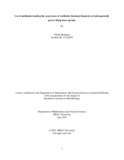Use of antibiotics leading the occurrence of Antibiotic Resistant Bacteria on hydroponically grown Mung bean sprouts.

View/
Date
2021-06Publisher
BRAC UniversityAuthor
Shahanaz, EshitaMetadata
Show full item recordAbstract
Antibiotics are used to prevent the growth of harmful bacteria that can cause plant disease
or associate to human disease during the development of food crops. The goal of this study was to
observe the effect of antibiotics on the organisms of mung bean sprouts, also if organisms residing
into sprouts achieve antibiotic resistance at different antibiotic concentration changes. Mung bean
sprouts were harvested on day seven following the final treatment of antibiotics (amoxicillin,
gentamicin, and ciprofloxacin) at concentrations of 100 ppm, 300 ppm, and 500 ppm) for one
week. This investigation discovered a community of complete aerobic bacteria as well as bacteria
that were resistant to antibiotics. Antibiotics had varying degrees of success in lowering organism
size. At a minimum dose of 100 ppm, all three antibiotics exhibited no significant reduction in
bacterial population on mung bean. Amoxicillin had little effect on microbial population,
gentamicin and ciprofloxacin inhibited some specific organisms, but there was a significant
reduction in total aerobic bacterial count, albeit it was not completely inhibited. Gentamicin and
ciprofloxacin showed a 1.5 log reduction in microbial population at concentrations of 300 and 500
ppm. Amoxicillin and gentamicin resistance was found in all of the microorganisms examined.
Ciprofloxacin suppressed some pathogens but did not completely suppress total aerobic bacterial
count and had an effect on sprout germination. In conclusion, antibiotic use does not effectively
suppress microbial populations, and a high percentage of microorganisms develop antibiotic
resistance. This investigation focuses on the various effects of antibiotics on mung bean sprouts,
as well as the necessity for effective antibiotic concentration management and data in order to
prevent the development of multi-antibiotic resistance bacteria through the consumption of fresh
mung bean sprout.
